Doodling is like taking your brain on a mini vacation; try loose spirals, swirling zigzags, leafy loops, and pebbly zen gardens to chill out fast. Mandalas offer hypnotic calm, while wild pattern tangos let your imagination run free. Stacking dots, curling waves, tangled lines, and freestyle mashups add playful fun—no art skills needed, just a favorite pen! Completing these doodles sparks real satisfaction, melts away stress, and brings relaxing surprises. Curious what other zen patterns can do?
Key Takeaways
- Experiment with simple mandala designs using repetitive shapes and patterns to promote mindfulness and calm.
- Draw overlapping spirals and wavy lines to create a relaxing, rhythmic doodling flow.
- Craft loopy leaves, wildflowers, or Zen garden pebbles for stress relief and gentle creative focus.
- Try freestyle, imperfect doodles—embracing mistakes to boost creativity and soothe anxiety.
- Layer dots, swirls, and geometric forms to build intricate, meditative patterns and foster present-moment awareness.
The Accidental Artist
Envision this: someone picks up a pen during a boring class or a long phone call, and—bam!—they’re suddenly on the path to becoming an accidental artist.
What starts as tiny, wiggly shapes or random zigzags in the margins of a notebook quickly becomes more. There’s no art teacher breathing down their neck, no rules, and definitely no “mistakes.”
Just pure, simple expression popping up in unexpected areas of my life, like the side of a math worksheet or on the back of a grocery receipt. People might discover patterns from their cereal swirls, or get inspired by the trees outside.
As the doodles pile up, stress melts away, confidence bubbles up, and each little line weaves a new part of their story.
The Spiral of Serenity
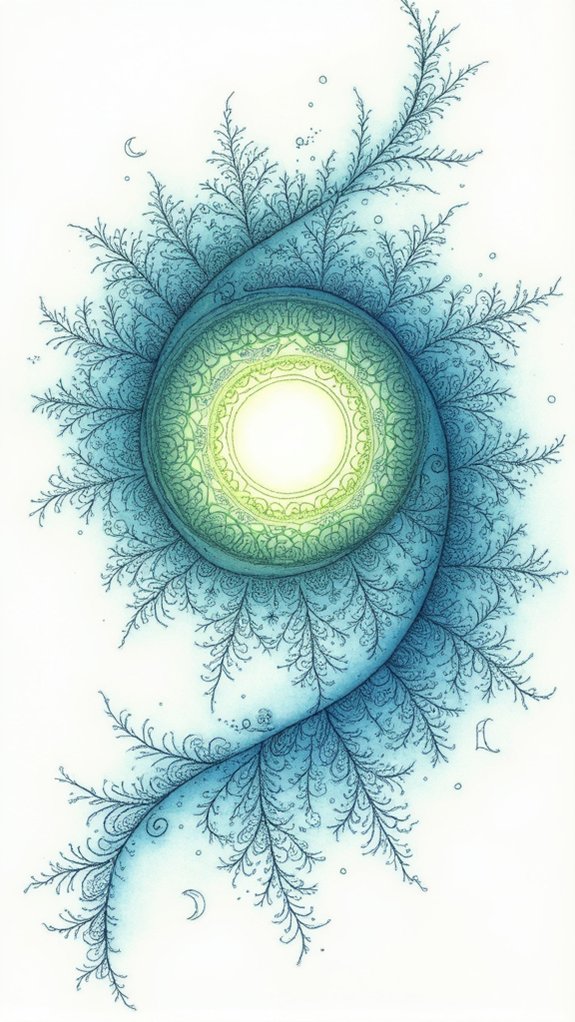
In the Spiral of Serenity, making wobbly, less-than-perfect spiral lines is actually part of the fun—nobody’s judging here except maybe your pencil.
There’s something oddly satisfying about getting into a groove with those repeating loops, almost like your hand is dancing across the page and your brain gets a chance to chill out.
Each spiral can be totally different too, whether you add zigzags, dots, or tiny cartoon faces, because personalizing your spiral is where the magic (and the giggles) really happen.
Embracing Imperfect Spiral Lines
Perfection can take a back seat when it comes to the Spiral of Serenity—a doodling technique that turns every bump, wobble, and lopsided curl into pure relaxation magic.
In the world of spiral meditation techniques, the fun’s in the twists and turns, not how neat the lines look. Doodling for mindfulness becomes a chill adventure as each imperfect spiral helps the mind settle, making stress and anxiety feel way less bossy.
Even though some spirals start to look like sleepy snails or wild tornadoes, that’s where creative expression freedom really shines.
Anyone, no matter their drawing skills, can find a groove in these spirals—mistakes just make each doodle more interesting. It’s about letting go, relaxing, and simply enjoying the spin.
Finding Rhythm in Repetition
Why does doodling the same spiral over and over feel so strangely satisfying? Maybe it’s the way those rhythmic patterns pull you in, one loop at a time, until suddenly the world seems quieter.
The Spiral of Serenity isn’t about perfect circles or steady hands—it’s about letting repetitive motion wash away worry. Seriously, who needs a zen garden when you’ve got a notebook and a pen?
Each wobble and turn brings a calming creativity that doesn’t care about straight lines or fancy art skills. Just the act of repeating the spiral helps your mind focus, making distractions fade into the scribbled background.
And when you see your page filling up, there’s a chill thrill in knowing you made something that’s uniquely yours.
Personalizing Your Spiral Designs
Some days, a person might crave a spiral that’s totally wild—filled with thick lines, sudden turns, or even some offbeat doodles stuffed in the gaps.
Personalizing a Spiral of Serenity is all about letting spiral inspiration flow! Instead of trying to make lines perfect, the wobbly bits become the real stars. Varying thickness adds a cool twist, and suddenly, each spiral gets its own mood.
Maybe one day, there are tiny hearts, or maybe squiggly lightning bolts—these unique embellishments let creativity run loose. Every little mark is a personal touch, making the spiral truly one-of-a-kind.
Besides being fun, this laid-back approach lowers stress—plus, all those hand movements actually boost drawing skills. The only rule? Add whatever makes you smile.
The Zen Zigzag
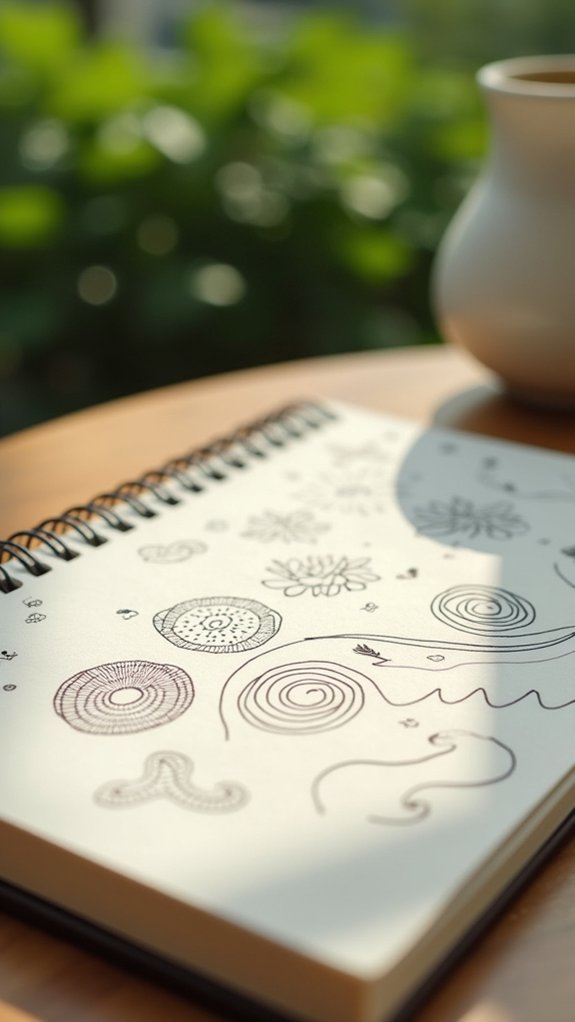
Even though it might look simple at first glance, the Zen Zigzag is more than just doodling a bunch of funky, jagged lines—it’s a whole adventure for your brain and your pencil.
Drawing these zigzag variations isn’t just a fun way to fill up a blank page; it’s actually one of the best calming techniques you can try anytime stress tries to crash your day. The back-and-forth motion helps your mind chill out, sort of like a peaceful mental ping-pong game.
Every doodle freedom moment lets your creativity take over, with unexpected line crossings and wild overlaps making each zigzag pattern unique.
Anyone can jump in—there’s no wrong way with the Zen Zigzag—just let your lines wander and enjoy the ride.
The Mindful Mandala
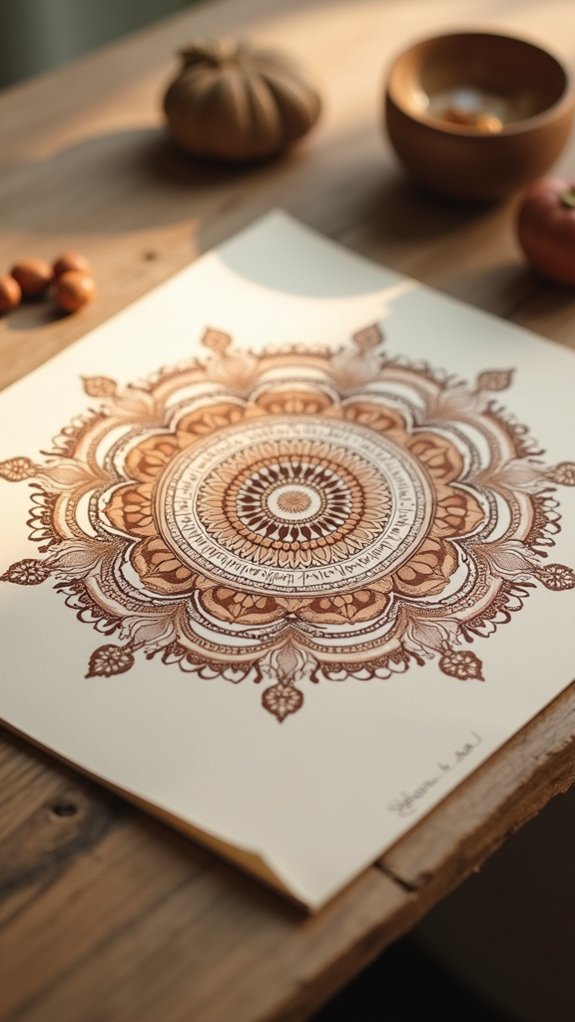
The Mindful Mandala is all about starting with easy shapes—like circles or petals—and then adding your own twists to make something totally unique and eye-catching.
It’s not just about looking cool; as people build up their patterns, they might notice their worries shrinking and their focus sharpening, kind of like the art is giving their thoughts a gentle stretch.
Forget chasing perfection—mandalas welcome everyone, mistakes and all, turning scribbles into a peaceful, mindful moment.
Starting Simple Mandalas
Mindfulness can take a surprising shape—sometimes, it’s just a few circles and dots coming together on paper.
Starting simple mandalas is like hitting pause on a noisy day and giving the mind a gentle reset. Anyone can try this mindful practice: no need for fancy skills, just a pencil and a willingness to explore.
It all begins with simple shapes, layering circles, dots, and lines, allowing creative exploration to flow freely. There’s no pressure for perfection; in fact, mistakes often make the best moments.
Here’s how the magic unfolds:
- Draw a small circle in the center—like the eye of a storm, totally calm.
- Add dots or lines spiraling outwards.
- Let patterns build, repeating and relaxing as the design grows.
No stress—just the joy of doodling.
Embracing Unique Patterns
When it comes to mandalas, there’s a special kind of magic that happens once someone dares to break away from just repeating the same shapes over and over.
Pattern exploration takes center stage, turning each doodle into a wild adventure of creative expression. Suddenly, triangles can dance with swirls, zigzags squeeze in beside hearts, and hey—why shouldn’t a pizza slice or a lightning bolt join the party?
The Mindful Mandala encourages everyone to toss out the rulebook and let their minds play. It’s not about perfection; it’s about mindful engagement and leaning into what feels right.
Whether you’re a stick-figure master or a secret Da Vinci, personalized mandalas become snapshots of your mood—each unique, each worth celebrating. No two doodles are ever alike!
Mandalas for Mindfulness
Pizza slices and lightning bolts might throw a wild party in a mandala, but there’s another superpower hiding inside these circular designs—mindfulness.
The Mindful Mandala kicks things off with simple shapes and patterns, drawing you into a zone where creative flow takes over. Getting lost in the swirl of mandala symbolism and color therapy isn’t just fun, it works serious calming magic on the mind.
Picture it:
- Start with easy circles and triangles—let your imagination fill in the rest.
- Choose colors that match your mood for a dash of color therapy (blue for chill, maybe neon green for energy).
- Watch your stress fade as you lose track of time, doodling your way to that sweet sense of creative accomplishment.
The Pattern Tango
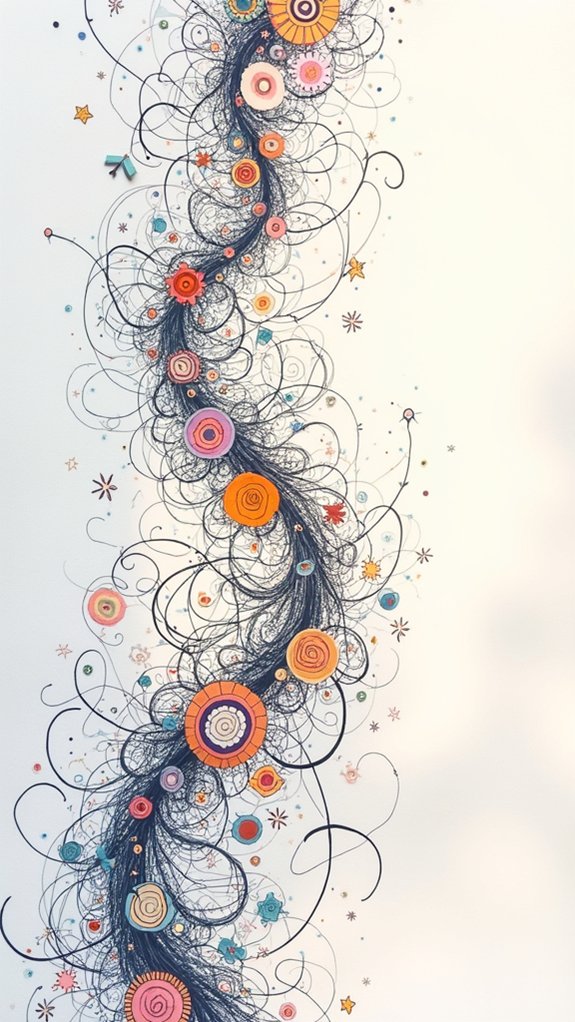
Creativity practically buzzes with excitement in The Pattern Tango, where doodle lovers get to fill their pages with wild, whimsical flowers. This part of doodle zen is all about whimsical expressions and letting joyful designs burst off the page. It’s a playful dance, not a strict routine—shapes twist and swirl however the hand decides. Beginner or pro, anyone can jump into this creative exploration! Repetitive petals and leaves help the mind calm down, making stress melt away with every stroke. Plus, there’s no such thing as messing up—every squiggle can be a flower. Just imagine:
| Loopy Leaves | Smiling Petals |
|---|---|
| Wavy Vines | Dancing Daisies |
| Swirling Stems | Giggling Tulips |
Each flower is a dose of pure, bright happiness.
The Wave of Wisdom
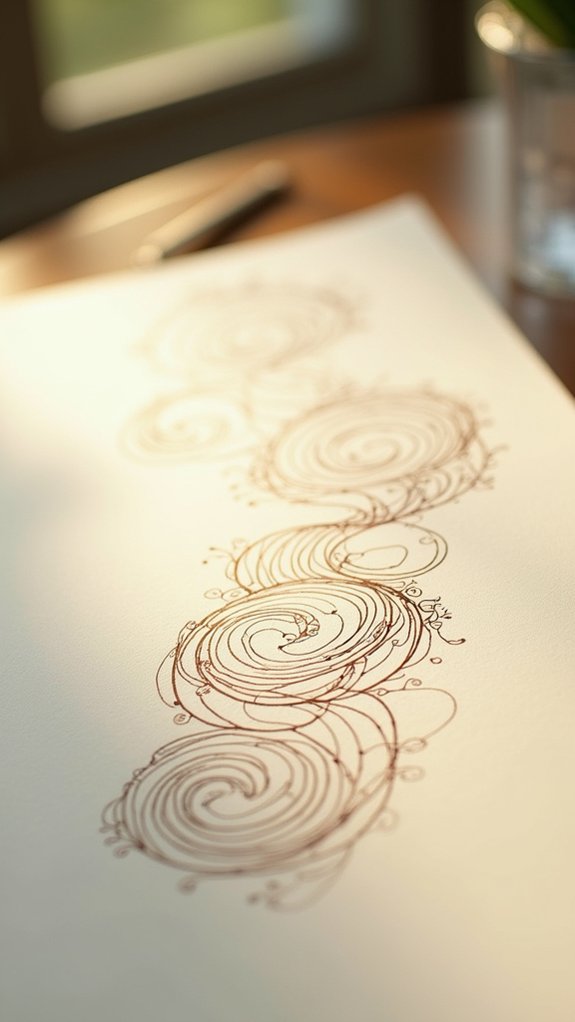
Wisdom sometimes glides in like a gentle ocean wave—unexpected but totally welcome.
The Wave of Wisdom doodle isn’t about perfect lines; it’s all about riding those twists and turns. With wave mindfulness guiding the pen, each curve becomes a lesson in going with the flow. This style lets artists embrace fluid expression, allowing doodles to roll and tumble just like real waves.
Therapeutic doodling here helps relax tense thoughts and smooth out stress, one gentle ripple at a time. Picture it like this:
- Draw imperfect, rolling waves that swoop across the page.
- Focus on the repetitive pattern, letting your mind drift into quiet calm.
- Watch as your lines reflect personal thoughts—some high, some low, all part of you.
Suddenly, doodling means feeling better.
The Dotty Dreamcatcher
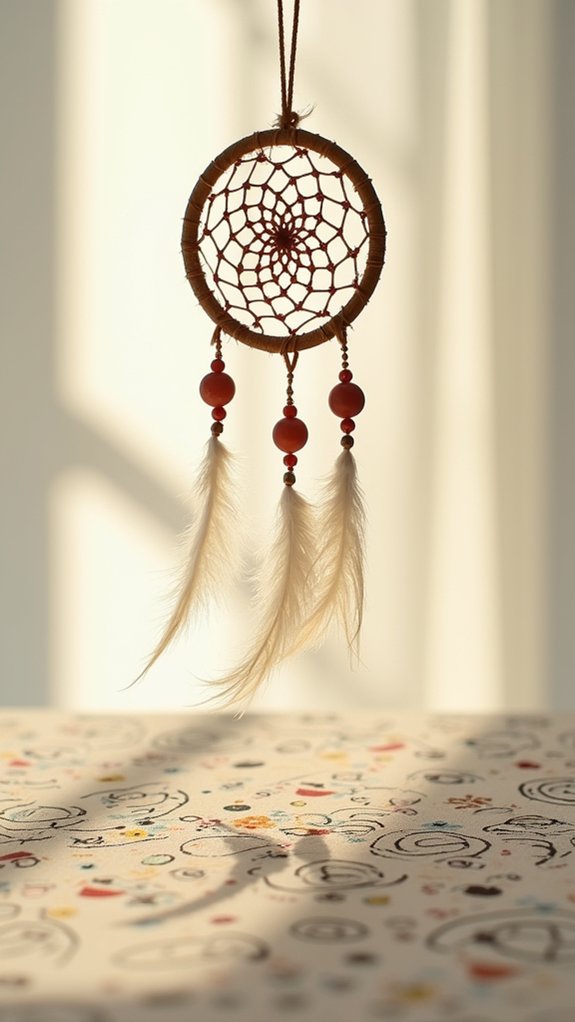
If there’s ever been a doodle that feels like catching dreams one dot at a time, it has to be the Dotty Dreamcatcher. Imagine this: you start with a clean page, tap out tiny dots, and before you know it—you’re swept into pure dotty design exploration. Each dot brings you closer to creative flow techniques, where there are no mistakes, only new patterns. Want to picture it? Here you go:
| Spotted circles | Lines linking dots |
|---|---|
| Tiny bursts | Expanding outward |
| Web of dreams | Patterns within dots |
Think of this doodle as pure meditative dot patterns—relaxing, and kind of sneaky in how it chases away bad vibes. Every dot becomes part of your own dreamcatcher story. Cool, right?
The Zen Garden

A Zen Garden isn’t just a patch of rocks and sand sitting quietly in someone’s backyard—it’s basically nature’s way of saying, “Hey, slow down and enjoy the calm.”
When it comes to doodling, the Zen Garden vibe is all about transforming a plain page into a peaceful escape, one wavy line or pebble swirl at a time.
Drawing Zen Garden Inspiration from real spaces, anyone can bring calm into their day by channeling those soothing Nature Patterns right onto paper.
With Mindful Doodling, it’s not just about creating; it’s about finding your chill.
Imagine this:
- Sketch flowing lines to mimic raked sand.
- Add clusters of rounded pebbles or stones.
- Sprinkle in minimalist plant shapes—ferns or mossy tufts.
Let stress drift away, one quiet doodle at a time.
The Floral Finale

Petals, vines, and bursts of color—The Floral Finale is where doodling really gets to show off its wild side.
Imagine swirling your pen to create wild roses one minute and sunflowers the next, diving deep into floral inspiration. There’s no pressure for perfect petals or symmetrical stems; your flower doodle techniques are totally up to you.
This style is all about creative relaxation, letting your mind drift as you repeat shapes and lines, sometimes getting lost and coming out with something totally new and quirky. It’s like giving your brain a flowery vacation!
And as you experiment with different patterns, your hands get steadier, your stress fades, and each doodle is another little victory—who knew a simple blossom could do all that?
The Unexpected Benefits of Doodling
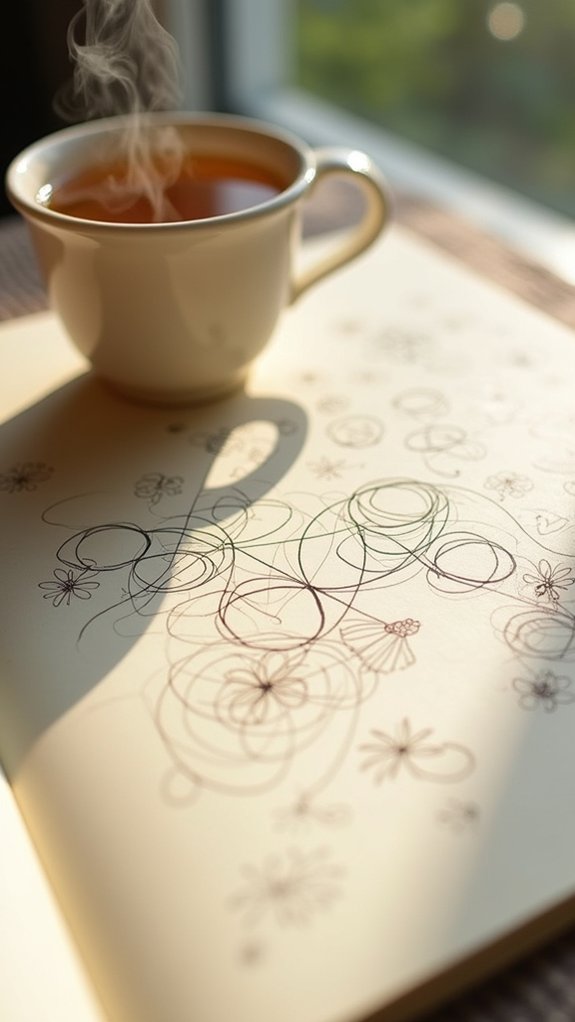
You might think doodling is just a way to pass the time, but it’s actually a secret tool for feeling calm and confident.
Drawing simple patterns over and over can help your mind slow down and focus, kind of like hitting a mental reset button. Plus, there’s something pretty awesome about finishing a doodle—no matter what it looks like, it gives you that little boost, like, “Hey, I made this!”
Mindfulness Through Repetition
Plenty of people don’t realize it, but doodling does more than just cover the edges of your notebook with squiggles and shapes—it can actually work wonders for the brain.
When someone picks up a pen and lets their mind wander into repetitive patterns, a surprising thing happens: their brain hushes, stress fades, and a sense of mindful reflection takes over.
It’s like a mini vacation for your thoughts, right in the middle of math class or a boring meeting. Here’s what doodling through repetition can do:
- Helps focus attention on the present—say goodbye to racing thoughts!
- Acts as a creative release, letting worries flow onto the page instead of your mind.
- Builds calm through hypnotic, soothing patterns, almost like active meditation.
Who knew squiggles could be so powerful?
Creative Confidence Boost
Confidence can be a tricky thing—it hides when you need it most and pops up in the weirdest places, like smack dab in the middle of a doodle-filled notebook. Doodling isn’t just random scribbles; it’s a creative expression technique that lets people play with shapes without pressure. By trying out simple confidence building activities—like filling a page with squiggles or drawing tiny patterns—anyone can access big artistic exploration benefits. It’s not about being perfect; in fact, embracing messy lines actually helps with self-acceptance! Even science backs it up: making repetitive doodles can boost focus and retention by up to 29%. Check out these surprising benefits:
| Benefit | How Doodling Helps |
|---|---|
| Reduces anxiety | Calms nerves through patterns |
| Fosters accomplishment | Finishing doodles builds pride |
| Sparks mindfulness | Brings focus to the present |
Embracing the Zen Doodle Journey
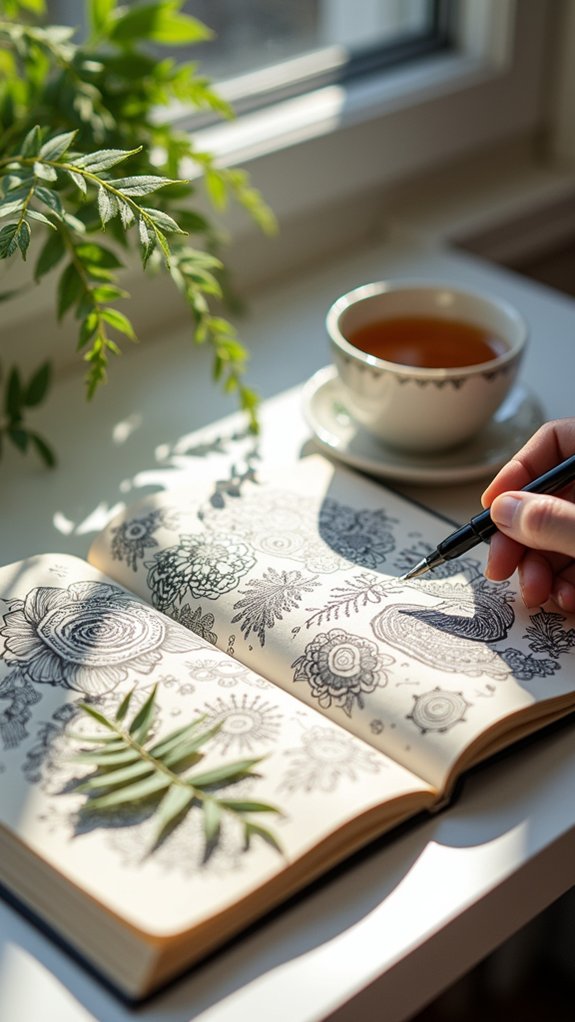
Even when a doodle looks nothing like the “plan,” the Zen Doodle journey is all about tossing perfection out the window and letting creativity take the wheel.
Instead of worrying about mistakes, people get to immerse themselves in creative exploration with wild, wavy lines and let personal expression shine, even if that means a squiggle army or a pattern that looks like a pancake stack!
Zen Doodling isn’t just drawing—it’s a path to mindful relaxation, a way to calm racing thoughts.
Here’s what the adventure might look like:
- Start with simple shapes—think circles, swirls, or zigzags.
- Let patterns grow naturally, layer by layer.
- Equip yourself with a favorite pen, sheet of paper, and some quiet time.
No rules, just doodles!
5-Day Zen Doodle Challenge
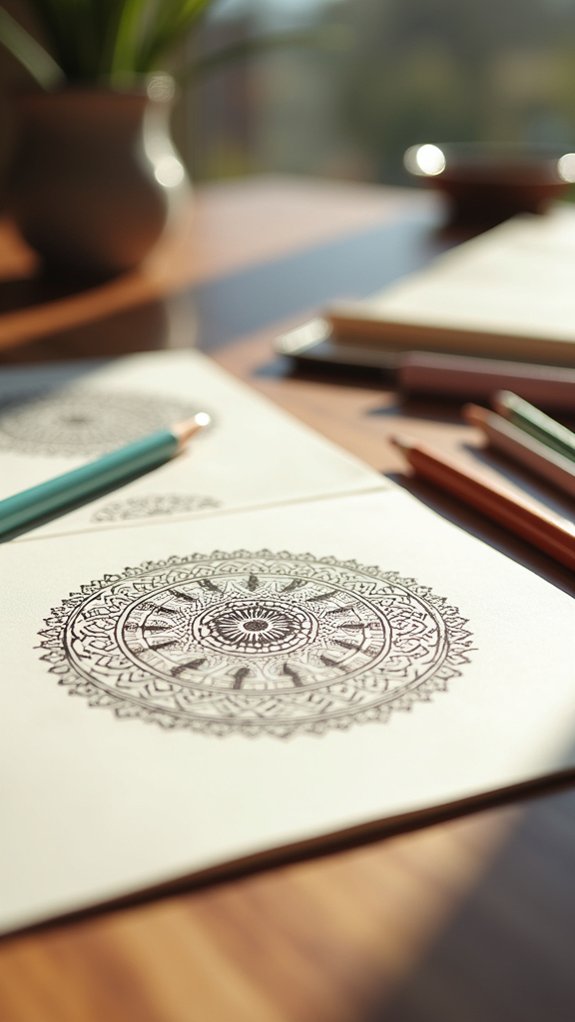
If you’ve ever wondered what would happen if a doodle adventure and a mindfulness exercise teamed up, the 5-Day Zen Doodle Challenge is ready to show you.
Each day is like opening a new box of doodle inspiration, inviting anyone to try creative relaxation, one pen stroke at a time.
Day 1 kicks off with overlapping spirals—no need for perfection, just pure artistic freedom!
By Day 2, everyone’s making mandalas with circles and lines; symmetry is cool, but messing it up on purpose can be pretty hilarious.
On Day 3, it’s time to smush patterns together and go wild.
The grand finale, Day 5, is all about freestyle doodling—total spontaneity, zero overthinking.
It’s stress-busting, surprising, and seriously fun!
Frequently Asked Questions
What Materials Do I Need to Start Zen Doodling?
To start zen doodling, individuals require basic materials such as paper and pens. Material preferences vary, with options including fine liners, markers, or colored pencils. Creative inspiration and diverse doodle techniques can further personalize the process.
Is Zen Doodling Suitable for Children?
The suitability of zen doodling for children is widely recognized. It offers benefits for children such as encouraging creative expression and serving as an introductory mindfulness practice, helping them develop focus and emotional regulation in an enjoyable way.
How Long Should a Typical Doodle Session Last?
Regarding doodle duration, a typical session might last between 10 to 30 minutes, depending on individual preference. For effective time management, individuals may benefit from choosing a session frequency that fits their lifestyle, such as daily or weekly.
Can Zen Doodling Help With Anxiety Symptoms?
Zen doodling may help with anxiety symptoms through mindfulness benefits, as the repetitive patterns foster focus and calm. Creative expression involved in doodling can promote stress relief, providing individuals with a healthy outlet for their emotions and thoughts.
Are There Digital Apps for Zen Doodling?
The current question explores the availability of digital tools and creative apps tailored for zen doodling. Numerous applications support various doodling techniques, enabling users to engage in relaxing, mindful doodling experiences directly on their digital devices.
Conclusion
In the end, doodling isn’t just about drawing silly squiggles—it’s a mini vacation for your brain. Whether you’re making spirals, wild zigzags, or calming mandalas, every line can quiet your worries and boost your mood. Next time life feels overwhelming, grab a pen and let your imagination take the wheel. Remember, there are no mistakes in zen doodling, only happy accidents—so relax, laugh at your weirdest shapes, and draw your stress away!

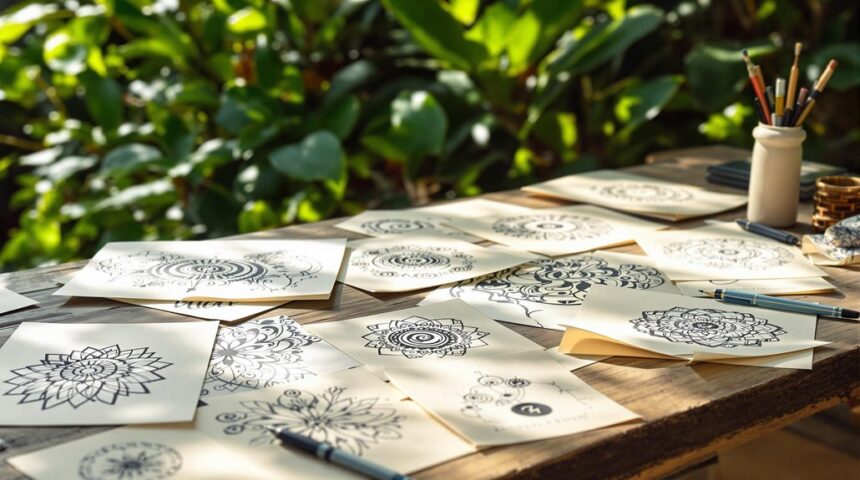
Leave a Reply